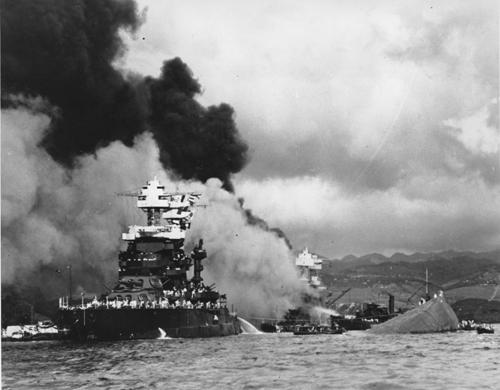Pearl Harbor anniversary draws interest in plight of civilians who survived Japanese attack

Torpedoed and bombed by the Japanese, the battleship USS West Virginia begins to sink, center, while the USS Maryland, left, is still afloat in Pearl Harbor, Oahu, Hawaii, in a Dec. 7, 1941 file photo. The capsized USS Oklahoma is at right. This year ma The Associated Press
Dec 7, 2007
Last updated on May 12, 2016 at 07:28 p.m.
HONOLULU – Children carried gas masks to the playground. Military officers commanded civilian courts under martial law. Residents feared enemy troops would parachute into the mountains and then swarm the beaches.
This year’s 66th anniversary of the Japanese attack on Pearl Harbor offers reminders of how the assault upended the lives of Hawaii’s civilians, in addition to the severe damage inflicted on the military.
“It was scary,” said Joan Martin Rodby, who had to carry a gas mask everywhere as a 10-year-old – even as she sat for her fifth-grade class portrait in 1942. “It was more or less living in constant fear they were always going to come back.”
Annual remembrances of the Dec. 7, 1941, attack often evoke images of burning ships in Pearl Harbor and exploding planes at Hickam Field. This year’s observance will be no different. But the plight of civilians who survived the attack has attracted more attention because of deepening interest in the home front during World War II.
Get The Daily Illini in your inbox!
“Maybe the unsung heroes that we should remember and look at are the civilians that endured the attack on Pearl Harbor and the years after it,” said Daniel Martinez, chief historian at the USS Arizona Memorial.
Civilian survivors who recall the attack include Hawaii’s two U.S. senators, who both were 17-year-old boys at the time.
Sen. Daniel Inouye, now 83, said he served as a first-aid volunteer, helping treat civilians who were wounded in his Honolulu neighborhood. In 1943, he joined a celebrated all-Japanese-American unit and was highly decorated for combat valor.
Japanese planes did not bomb residential neighborhoods, but misfired U.S. anti-aircraft shells fell on homes and businesses.
“One shell fell into the dining room and this old Japanese lady was having her breakfast. When I got there she was slumped over in her food,” Inouye said in an interview. “Shrapnel went through her head and killed her. She didn’t know what hit her.”
Inouye said about a half-dozen storekeepers were killed when their shops were hit.
The National Park Service, which runs the USS Arizona Memorial, lists 48 civilians who died from the attack, mostly in Honolulu. Three firefighters and four federal government employees also perished.
Military casualties far outnumbered civilians, with more than 2,300 dead and 1,100 wounded. All the dead are to be remembered Friday in a ceremony at a Pearl Harbor pier overlooking the USS Arizona, which sank with more than 1,000 sailors aboard.
In the months after the attack, the war crept into all aspects of civilian life.
Lei-makers made camouflage nets instead of flower garlands. The U.S. military lined Waikiki beaches with barbed wire, giving the island the look of paradise under siege.
A blackout order was imposed to make sure invading Japanese forces would not have any city lights to guide them in an attack. Neighborhood wardens made sure residents turned off lights and covered windows with black cloth.
Rodby’s husband, Dick, and his family wanted to evacuate from their home across from the Schofield Barracks Army base to a beach house on Oahu. But they were told not to because Japanese forces might storm the beaches.
Hawaiian Sen. Daniel Akaka was a senior at a military academy when the raid happened. He and his classmates were ordered to guard the mountains behind their hillside campus after the attack.
The U.S. military feared Japan would send paratroopers into the mountains and sabotage the island’s water sources, so it asked the students to help.
“We were ordered to take care of the hills,” Akaka told The Associated Press.
Martial law was declared the afternoon of Dec. 7. Military officers replaced civilian judges, meaning even people caught speeding or committing other traffic violations were judged in military court.
“We went from the Gibraltar of the Pacific to this isolated outpost,” Martinez said. “The islands of Hawaii were still at risk. As such, it was constant: ‘When are they coming back? Will we be invaded, will we be occupied?'”
The mood relaxed somewhat by mid-1942, after the U.S. military victory at the Battle of Midway, which dramatically reduced the chance Japan would attack Hawaii again. But martial law remained in effect until 1944.
Martinez said there’s been growing interest in the experience of civilians during the war, as shown by recent displays on martial law at the Hawaii state judiciary museum and the U.S. Army Museum in Waikiki.
The park service plans to build a new USS Arizona Memorial visitors center in the coming years, and it will expand the civilian side of the story.
“It’s been neglected,” Martinez said.





